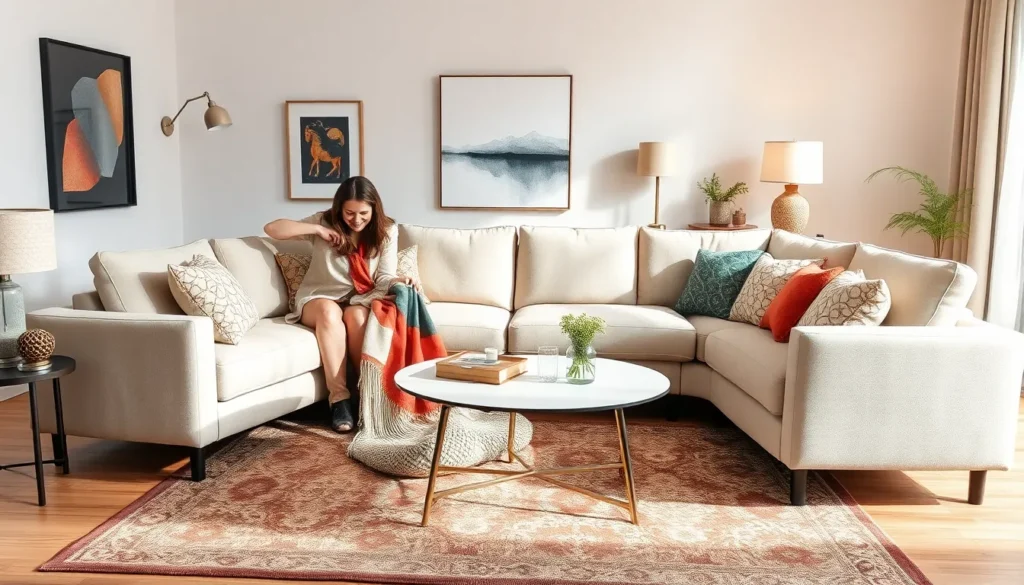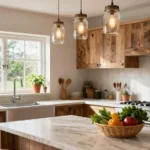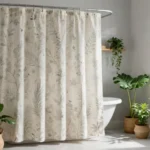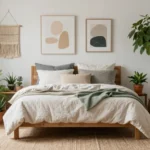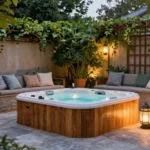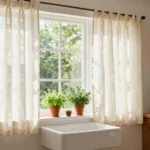Your living room serves as the heart of your home where family gathers and memories unfold. We understand that choosing the right furniture can transform this essential space from ordinary to extraordinary. The perfect combination of seating, storage, and statement pieces creates an atmosphere that reflects your personality while maximizing both comfort and functionality.
We’ve discovered that successful living room design isn’t just about following trends—it’s about creating a harmonious balance between style and practicality. Whether you’re working with a cozy apartment or a spacious family room, the right furniture choices can make your space feel larger, more inviting, and perfectly customized to your lifestyle.
From versatile sectional sofas that anchor your seating area to clever storage answers that eliminate clutter, we’ll guide you through proven furniture ideas that elevate any living room. Get ready to discover how strategic furniture placement and smart selections can completely revolutionize your most important gathering space.
Choose the Perfect Sofa as Your Living Room Centerpiece
Your sofa selection sets the foundation for your entire living room design. This central piece influences everything from traffic flow to color coordination throughout your space.
Consider Your Room Size and Layout
Measure your space carefully before falling in love with any sofa design. We recommend leaving at least 18 inches between your sofa and coffee table for comfortable movement. Small living rooms benefit from sofas measuring 72 to 84 inches in length, while larger spaces can accommodate pieces up to 120 inches wide.
Position your sofa to create natural conversation areas and maintain clear pathways. Corner placement works well in compact rooms, allowing you to maximize seating without blocking doorways or windows. Open floor plans need sofas that define separate zones while maintaining visual flow between areas.
Scale matters when selecting your centerpiece furniture. Oversized sofas overwhelm small rooms and make spaces feel cramped, while tiny sofas get lost in expansive areas. We suggest sketching your room layout or using painter’s tape to outline sofa dimensions on your floor before purchasing.
Select the Right Fabric and Color
Durability should guide your fabric choice for living room centerpieces that see daily use. Microfiber and performance fabrics resist stains and wear better than delicate materials like silk or linen. Leather offers longevity but requires exact care routines to maintain its appearance.
Color selection impacts your room’s mood and maintenance requirements. Neutral tones like gray, beige, and navy provide versatility for changing decor styles and hide everyday wear better than white or cream options. Bold colors work well as accent pieces but may limit your future decorating flexibility.
Texture adds visual interest without overwhelming your living room design. Velvet creates luxury appeal, while textured weaves bring casual comfort to family spaces. We recommend testing fabric samples in your actual lighting conditions since colors appear different under various light sources.
Decide Between Sectional and Traditional Styles
Sectional sofas maximize seating capacity in corner spaces and open floor plans. L-shaped configurations work well in square rooms, while U-shaped sectionals suit large rectangular spaces with multiple entry points. Modular sectionals offer flexibility for rearranging your living room layout as needs change.
Traditional sofas provide classic elegance and easier room rearrangement options. Three-seat sofas paired with accent chairs create balanced furniture groupings and allow for more varied seating arrangements. This style works better in formal living rooms or spaces that require frequent furniture repositioning.
Consider your lifestyle when choosing between these centerpiece options. Families with children often prefer sectionals for movie nights and casual gathering, while couples or individuals might favor traditional sofas for sophisticated entertaining. Your decision should reflect how you actually use your living room rather than just aesthetic preferences.
Create a Functional Coffee Table Setup
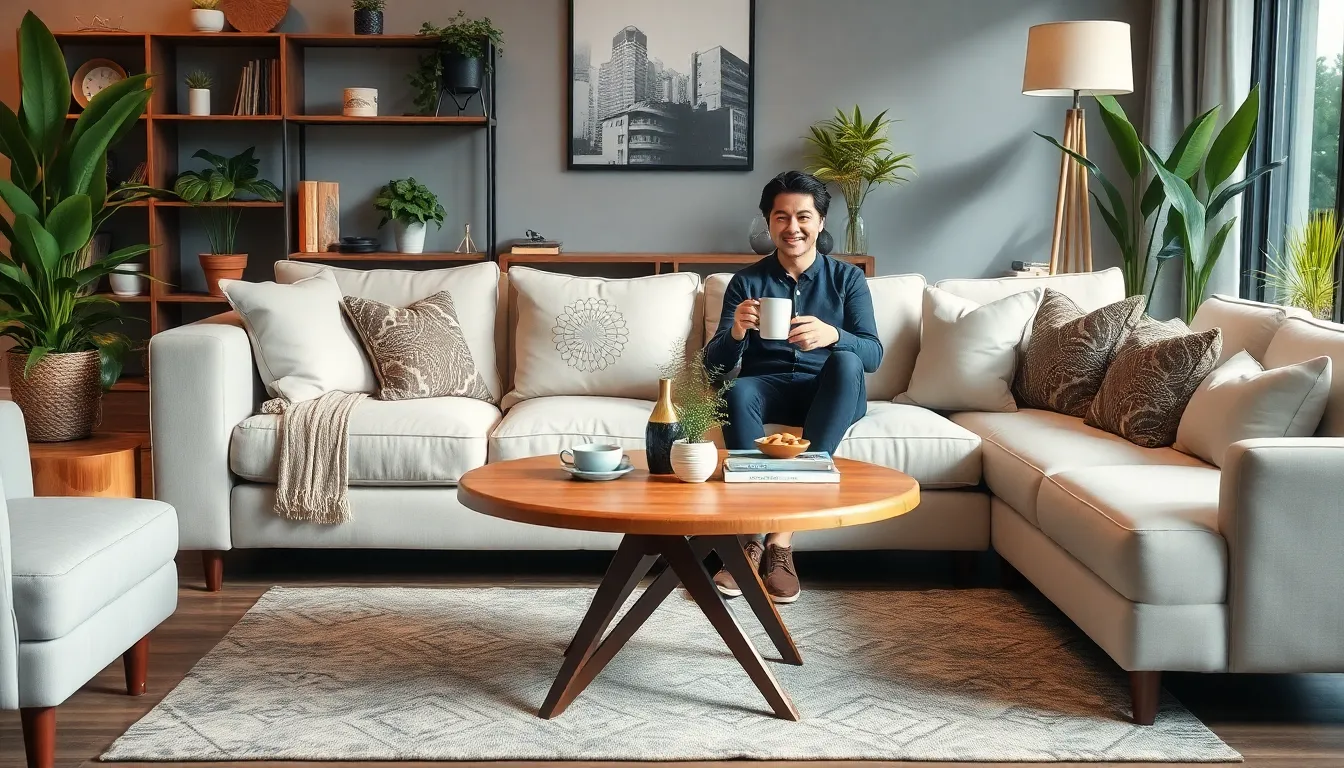
Building on your sofa selection, we’ll focus on creating a coffee table arrangement that enhances both style and everyday usability.
Match Your Coffee Table to Your Sofa Height
Height coordination ensures comfortable conversation and seamless usability throughout your daily routines. We recommend positioning your coffee table at a height that aligns closely with your sofa cushions for optimal accessibility. Standard coffee tables typically measure 16 to 18 inches high, which works perfectly with most traditional sofas that sit between 17 to 19 inches from the floor.
Distance matters just as much as height when creating your ideal setup. Keep approximately 14 to 18 inches between your sofa and coffee table to allow comfortable legroom while maintaining easy reach for drinks, books, or remote controls. This spacing prevents the area from feeling cramped while ensuring everything stays within arm’s reach during relaxed conversations.
Choose Between Round, Square, or Rectangular Shapes
Shape selection directly impacts your room’s flow and functionality based on your exact space dimensions. Round coffee tables work exceptionally well in smaller living rooms because they create a fluid, open feel without sharp corners that can obstruct movement. These curved designs promote easier navigation around the furniture and soften the overall aesthetic.
Square coffee tables suit square-shaped rooms perfectly and add a distinctly modern touch to contemporary spaces. They provide ample surface area while maintaining balanced proportions that complement sectional sofas or symmetrical seating arrangements. Square designs work particularly well when you need substantial tabletop space for entertaining or displaying decorative items.
Rectangular coffee tables excel in longer, more traditional living room layouts where they can anchor the seating area effectively. These classic shapes offer the most surface area and work beautifully with standard three-seat sofas or multiple seating pieces arranged in linear configurations.
Add Storage Options for Maximum Functionality
Storage integration transforms your coffee table from a simple surface into a powerful organizational tool. We suggest incorporating drawers, shelves, or built-in baskets to keep everyday items organized while maintaining a clean, uncluttered appearance. These hidden compartments excel at storing remote controls, magazines, coasters, and charging cables.
Layered storage answers enhance functionality without sacrificing your room’s visual appeal. Ottoman-style coffee tables with lift-top storage provide extra seating during gatherings while concealing blankets, board games, or seasonal decorations. Alternatively, tables with lower shelving offer easy access to frequently used items like books or decorative storage baskets.
Multi-functional storage pieces distribute visual weight effectively while serving multiple purposes throughout your daily routines. Consider coffee tables with built-in wine racks, magazine holders, or slide-out trays that adapt to different activities like working on laptops, serving snacks, or organizing entertainment essentials.
Design an Eye-Catching Entertainment Center
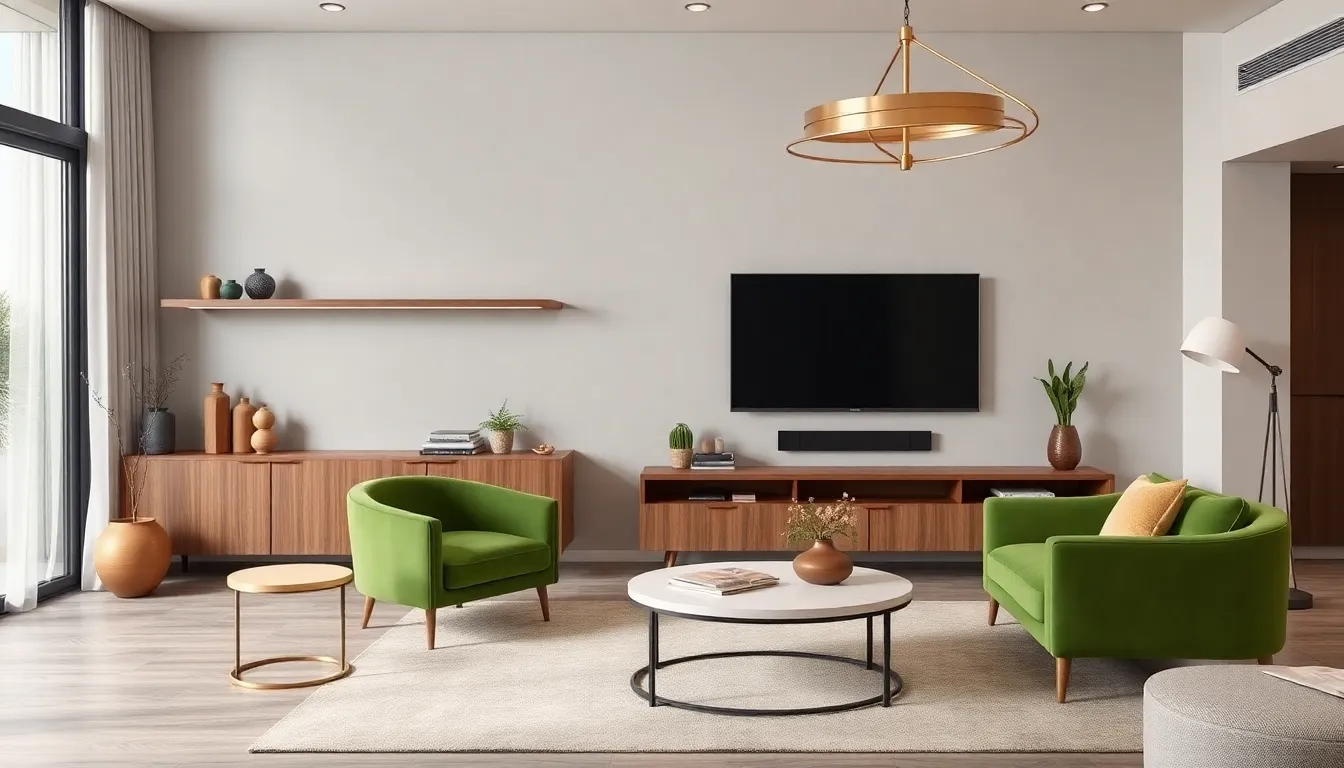
Building on your coffee table foundation, we’ll help you create an entertainment center that serves as a stunning focal point while maximizing functionality. Smart design choices make all the difference in achieving that perfect balance between visual appeal and practical storage.
Wall-Mounted vs. Freestanding TV Consoles
Wall-mounted consoles deliver a sleek, space-saving solution that instantly creates a minimalist aesthetic in your living room. These floating units work exceptionally well in smaller spaces where floor real estate is precious, and they’re ideal when you want to maintain clean sight lines throughout the room.
Freestanding consoles offer unmatched flexibility since you can easily move or rearrange them as your needs change. Storage capacity becomes a major advantage with these pieces, as they typically provide more room for media devices, gaming consoles, and decorative accessories. We’ve found that freestanding options work particularly well with modular sectionals, as both pieces can adapt to different room configurations over time.
Consider your lifestyle when making this choice. Families with young children often prefer wall-mounted units to keep electronics safely out of reach, while entertainment enthusiasts typically gravitate toward freestanding consoles for their superior storage capabilities.
Incorporate Cable Management Answers
Cable organizers and hidden compartments within your entertainment center keep unsightly wires completely out of view. This simple addition transforms a potentially cluttered setup into a polished, professional-looking focal point that enhances your living room’s overall aesthetic appeal.
Built-in cable management systems work seamlessly with both wall-mounted and freestanding consoles. Routing channels, cord covers, and discrete openings allow you to connect multiple devices without creating visual chaos. Strategic placement of these answers ensures easy access for maintenance while preserving the clean lines that make modern entertainment centers so appealing.
Power strips with surge protection can be concealed within designated compartments, keeping your valuable electronics safe while maintaining that clutter-free appearance we’re aiming for.
Balance Function with Aesthetic Appeal
Materials and designs should align perfectly with your living room’s existing style theme, whether you’re embracing natural textures, patinated finishes, or bold contemporary elements. Low-profile furniture continues to dominate design trends because it creates an immediate sense of openness and visual breathing room.
Storage ottomans and multi-functional coffee tables that double as work surfaces maximize your entertainment area’s versatility. These pieces complement curved sofas and bold lighting fixtures while providing practical answers for everyday living needs.
Vibrant maximalism trends encourage incorporating bold colors like green velvet and peacock blue into your entertainment zone. Statement seating pieces and carefully chosen antiques add layers of visual depth that prevent your entertainment center from feeling too sterile or purely functional.
Add Comfort with Strategic Accent Seating
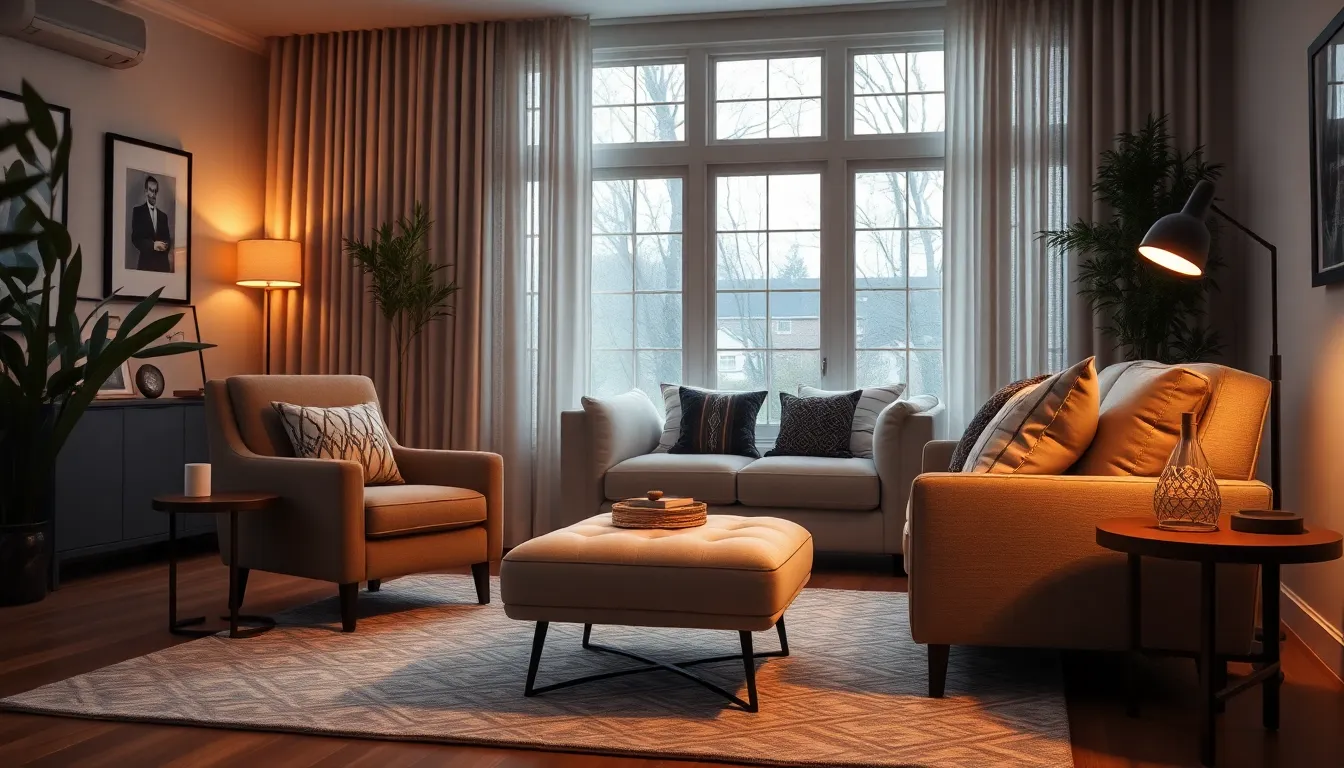
Accent seating transforms our living room from a basic furniture arrangement into a welcoming space that encourages relaxation and conversation. These additional seating options provide flexibility for entertaining while improving the room’s overall aesthetic appeal.
Include Armchairs for Extra Seating
Armchairs serve as essential backup seating when we’re hosting larger gatherings or need additional comfort zones throughout our living space. We can choose armchairs that complement our existing sofa style, whether we prefer modern minimalist designs, traditional upholstered pieces, or eclectic vintage finds.
Strategic armchair placement creates natural conversation clusters without overwhelming our room’s flow. Position armchairs at angles to the main sofa to encourage face-to-face interaction while maintaining clear pathways through the space.
Versatile armchair styles adapt to different occasions and needs throughout our daily routines. Select pieces with sturdy construction and comfortable cushioning that can handle regular use while maintaining their shape over time.
Consider Ottoman Versatility
Ottomans deliver multi-functional benefits that make them perfect additions to any living room furniture collection. These versatile pieces serve as footrests during movie nights, extra seating when friends visit, and even temporary coffee tables for casual dining or game nights.
Storage ottomans provide hidden compartments for keeping throw blankets, magazines, and remote controls organized while maintaining our room’s tidy appearance. Choose ottomans with lift-top lids or interior dividers to maximize their organizational potential.
Mobility becomes a key advantage when we select lightweight ottomans that can easily move around our space as needed. Rolling ottomans offer even more flexibility, allowing us to reposition them effortlessly for different activities or room configurations.
Place Accent Chairs in Conversation Areas
Accent chairs positioned near fireplaces or in cozy corners create intimate spaces where conversations naturally flow and connections deepen. These strategic placements foster social interaction by providing comfortable seating options away from the main television viewing area.
Plush materials and comfortable designs ensure our accent chairs contribute to the overall coziness we want to achieve in our living space. Select chairs with supportive cushioning and soft fabrics that invite people to sit and stay awhile.
Conversation areas benefit from accent chairs that face each other or angle toward a central focal point like a coffee table or artwork. This arrangement encourages eye contact and natural dialogue while creating distinct zones within our larger living room layout.
Maximize Storage with Stylish Solutions
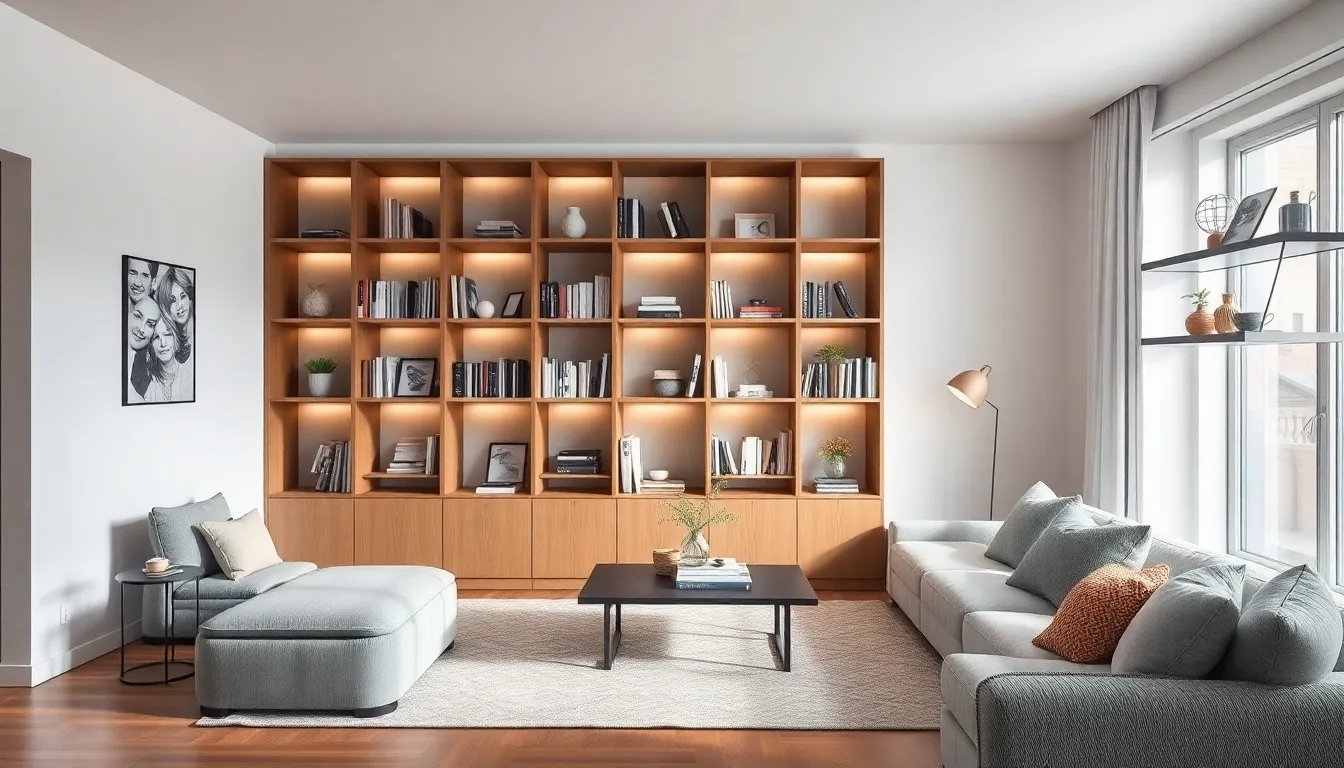
Smart storage answers transform cluttered living rooms into organized, stylish spaces that work harder for you. We’ll explore furniture pieces that seamlessly blend functionality with aesthetic appeal to keep your living room both beautiful and practical.
Use Bookcases as Room Dividers
Bookcases serve dual purposes by separating areas within your living room while providing essential storage space. Open-back bookshelf units create natural room divisions without blocking light flow, making them perfect for defining conversation areas or creating a home office nook within your living space.
Strategic placement of bookcase dividers helps organize your room’s layout while storing books, decorative items, and everyday essentials. Floor-to-ceiling units maximize vertical storage and create dramatic visual impact, while shorter bookcases maintain sight lines across the room.
We recommend choosing bookcases with varying shelf heights to accommodate different items, from large coffee table books to small decorative objects. Mixed storage keeps your living room organized while adding visual interest through carefully curated displays.
Incorporate Hidden Storage Ottomans
Storage ottomans offer the perfect solution for keeping your living room clutter-free while providing flexible seating options. These versatile pieces hide pillows, blankets, extra clothing, and seasonal items inside their spacious compartments, maintaining a neat appearance in your main living area.
Choose ottomans with sturdy construction that can support both storage weight and occasional seating needs. Upholstered designs blend seamlessly with your existing furniture while providing comfortable footrests during movie nights or casual conversations.
We suggest selecting ottomans with easy-access hinged tops for quick retrieval of stored items. Round ottomans work well in smaller spaces, while rectangular designs complement sectional sofas and provide more storage capacity for larger households.
Add Floating Shelves for Display and Function
Floating shelves maximize vertical wall space without overwhelming your living room’s visual flow. These sleek storage answers display decorative items, books, and art while keeping frequently used items within easy reach.
Corner installations make excellent use of awkward spaces that traditional furniture can’t fill effectively. Staggered shelf arrangements create ever-changing visual displays while providing practical storage for everything from remote controls to family photos.
We recommend installing floating shelves at eye level for optimal accessibility and visual impact. Group shelves in odd numbers for more appealing arrangements, and leave some breathing room between displayed items to avoid a cluttered appearance.
Enhance Ambiance with Proper Lighting Furniture
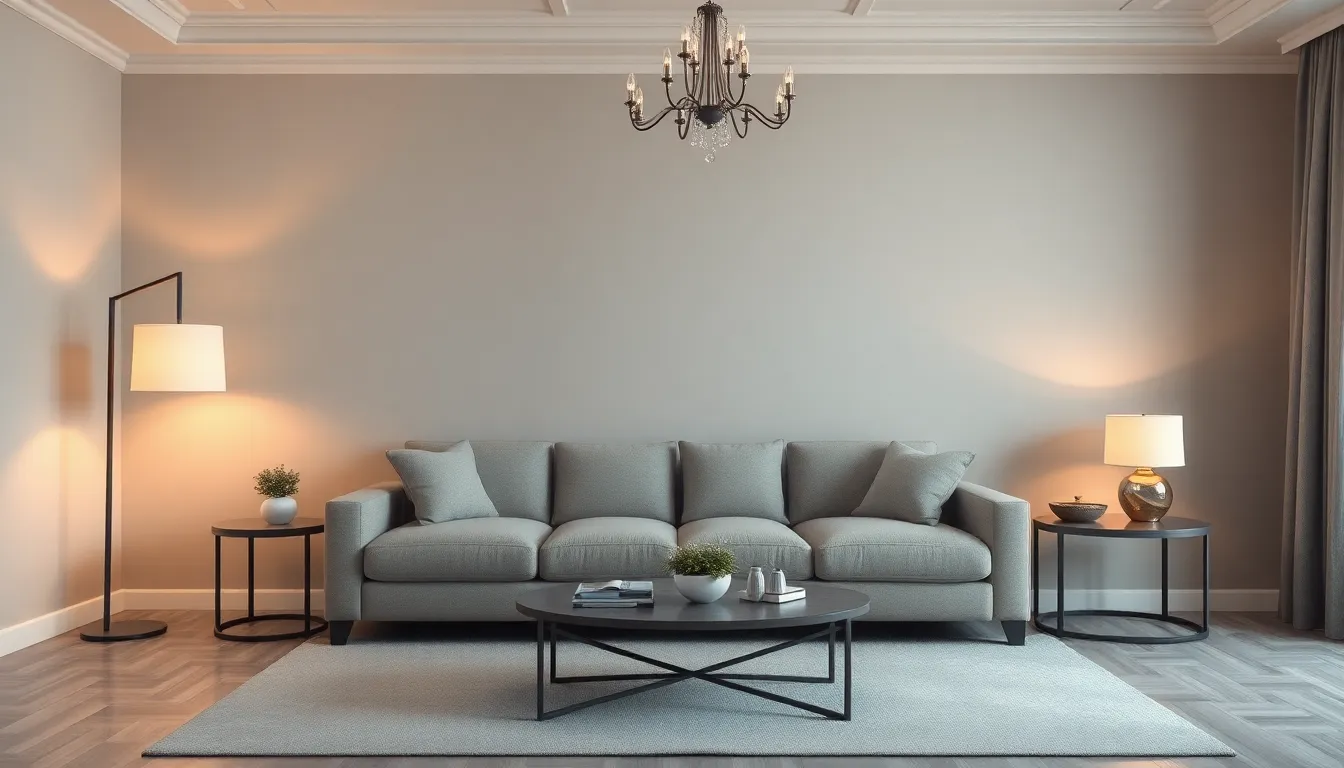
Strategic lighting furniture transforms our living room from simply functional to genuinely inviting. Well-placed lighting pieces create layers of illumination that enhance both daily activities and social gatherings.
Position Floor Lamps for Task and Ambient Lighting
Corner placement of floor lamps creates instant ambient lighting that softens harsh overhead illumination. We recommend positioning these fixtures behind seating arrangements or in empty corners to eliminate dark spots while maintaining a warm atmosphere throughout the room.
Task-focused floor lamps serve reading nooks perfectly by providing concentrated light exactly where we need it most. Adjustable designs allow us to direct illumination toward exact activities like reading or crafting without disturbing others in the space.
Strategic positioning behind furniture prevents glare while creating a subtle glow that makes our living room feel more spacious. This placement technique works especially well with sectional sofas where traditional table lamps might not reach all seating areas effectively.
Use Table Lamps on Side Tables
Table lamps on side tables provide essential task lighting for activities like reading magazines or having intimate conversations. These fixtures offer controllable illumination that complements overhead lighting without overwhelming the space.
Decorative table lamps add visual interest to side tables while serving practical purposes throughout the day. We can choose designs that reflect our personal style while ensuring the proportions match our furniture scale appropriately.
Paired table lamps create symmetry when placed on matching side tables flanking a sofa or bed. This balanced approach provides even lighting distribution while maintaining a cohesive design aesthetic that ties our room together beautifully.
Consider Unique Lighting Fixtures as Statement Pieces
Chandeliers serve as dramatic centerpiece lighting that immediately draws attention and elevates our living room’s sophistication level. These fixtures work particularly well in rooms with higher ceilings where they can make a bold visual impact without overwhelming the space.
Pendant lights offer modern alternatives to traditional chandeliers while providing focused illumination over exact areas like seating groups or accent tables. We can hang multiple pendants at varying heights to create ever-changing visual interest.
Statement lighting fixtures combine style with functionality by layering general ambient and accent lighting throughout our living room. This approach allows us to highlight architectural features artwork or bookshelves while maintaining overall room illumination for daily activities.
Define Spaces with Area Rugs and Side Tables
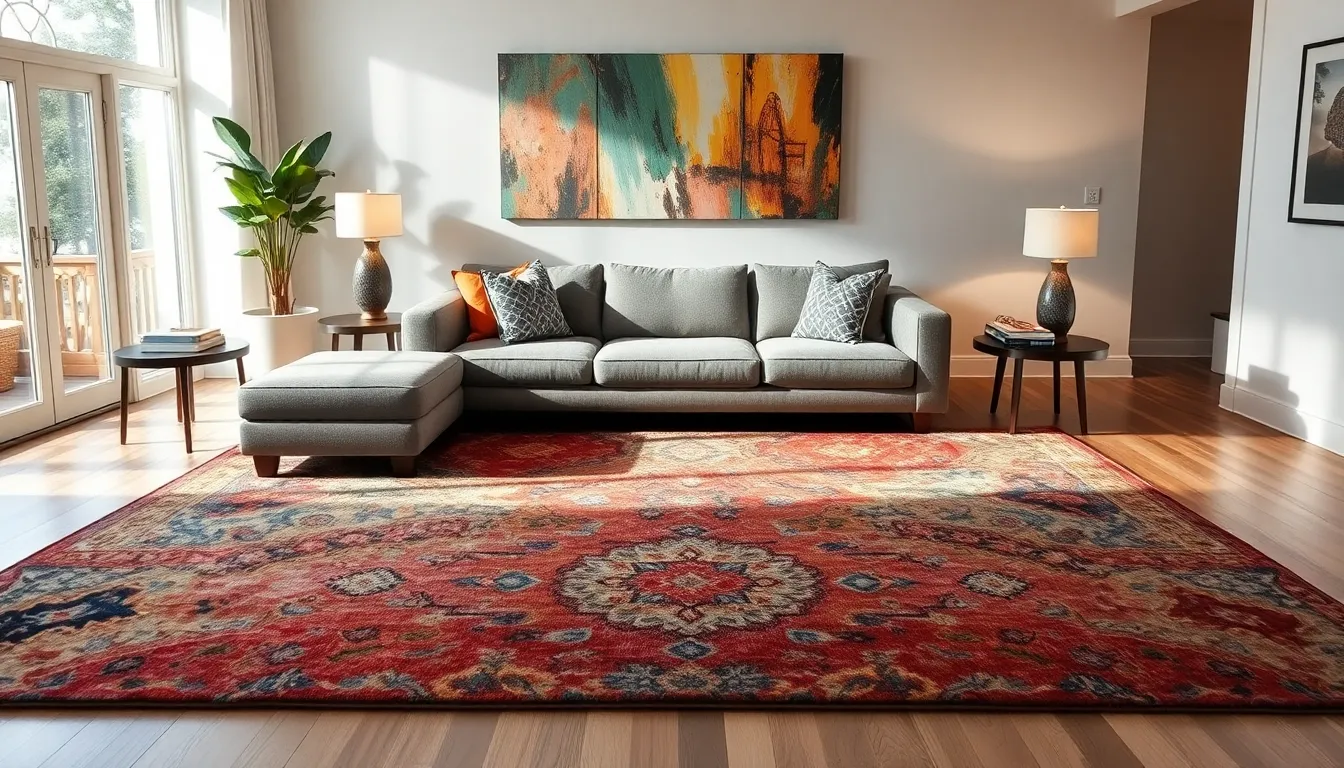
Area rugs and side tables work together to create defined zones within your living room while adding both functionality and style. These essential pieces help establish visual boundaries and provide convenient surfaces for daily activities.
Choose the Right Rug Size for Your Seating Area
Selecting the proper rug dimensions ensures your seating arrangement feels cohesive and proportional. A 9’x12′ rug works perfectly for most average-sized living rooms, providing adequate coverage without overwhelming the space. We recommend measuring your seating area first, then choosing a rug that accommodates all major furniture pieces.
Position your rug so the front legs of your sofa and chairs rest on it, creating a unified seating cluster. This approach anchors your furniture arrangement and prevents the room from feeling disconnected. Larger rugs make small spaces appear more expansive, while smaller rugs can break up oversized rooms into intimate conversation areas.
Place Side Tables Within Arm’s Reach
Strategic side table placement enhances both comfort and functionality throughout your living space. Position these surfaces within easy reach of your seating to create convenient spots for lamps, books, drinks, and remote controls. We suggest placing side tables no more than 18 inches from the edge of your sofa or chair arms.
Height coordination matters when selecting side tables for your arrangement. Choose tables that align with or sit slightly below your sofa arm height for optimal accessibility. This positioning allows you to reach items comfortably without stretching or leaning awkwardly during conversations or relaxation time.
Consider the traffic flow around your side tables to avoid creating obstacles in walkways. Round or oval tables work well in tight spaces since they eliminate sharp corners that might impede movement. Square and rectangular options provide more surface area but require adequate clearance on all sides.
Use Rugs to Create Visual Boundaries
Area rugs serve as powerful tools for defining different functional zones within your living room. Place a rug under your main seating area to separate it visually from dining spaces, entryways, or home office corners. This technique works especially well in open floor plans where walls don’t naturally divide spaces.
Different rug patterns and textures can reinforce the distinct purposes of each zone you create. We recommend using complementary colors and styles that flow together while maintaining clear boundaries between areas. Bold patterns work well for entertainment zones, while subtle textures suit quiet reading corners.
Layer rugs of varying sizes to add depth and interest to your room’s layout. Smaller accent rugs can define exact seating arrangements within larger open areas, creating intimate conversation spaces that feel separate from high-traffic zones.
Incorporate Multi-Purpose Furniture for Small Spaces
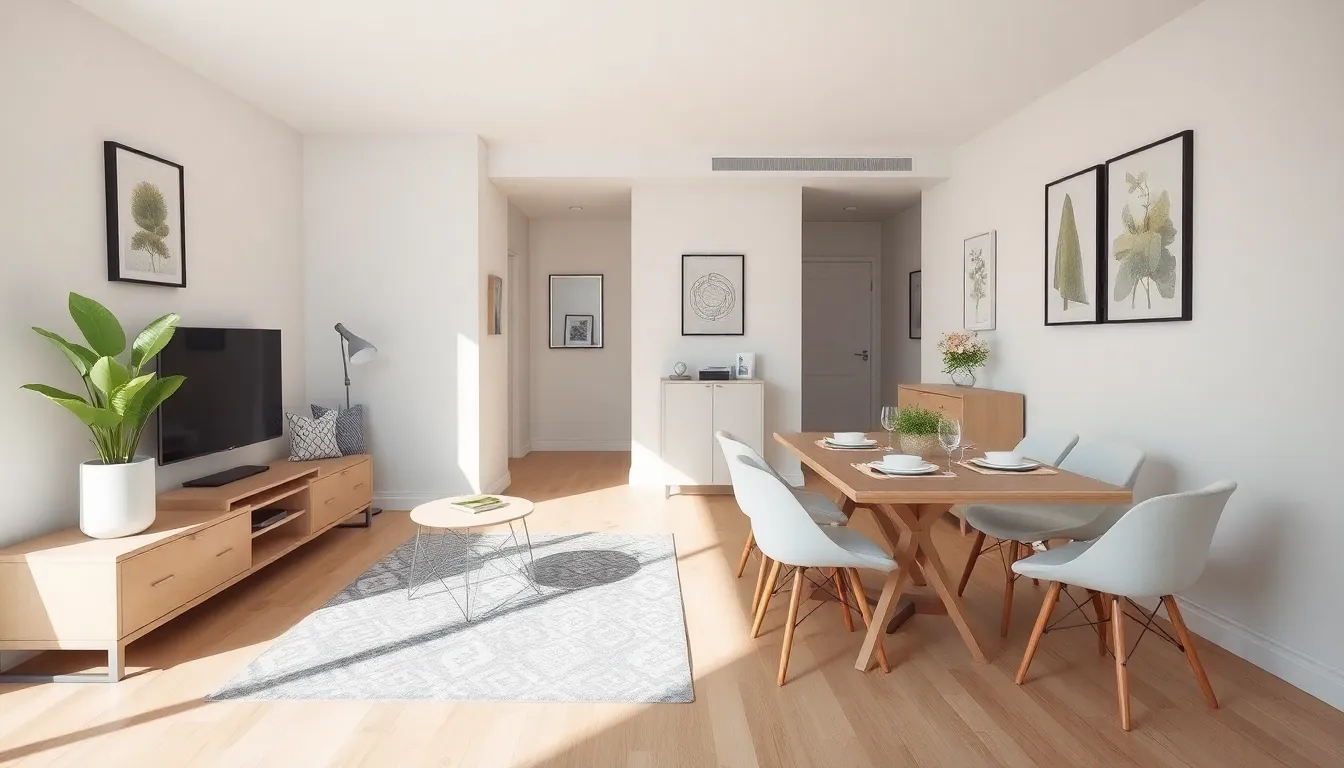
Small living rooms demand furniture that works twice as hard, and multi-purpose pieces transform cramped quarters into functional, stylish spaces. We’ve found that strategic furniture choices can maximize every square foot while maintaining the comfort and aesthetic appeal you desire.
Choose Nesting Tables for Flexibility
Nesting tables revolutionize small space living by offering instant storage and surface answers. These compact table sets nest perfectly under larger pieces when not needed, freeing up valuable floor space for daily activities. We recommend positioning them near your main seating area where they can be easily pulled out for drinks, snacks, or laptop work.
Flexibility becomes your greatest asset with nesting tables since they adapt to any gathering size or room configuration. You can spread them throughout the room for intimate conversation areas or keep them clustered for larger entertaining needs. Their lightweight design makes repositioning effortless, allowing you to transform your living room layout in seconds.
Use Storage Benches as Extra Seating
Storage benches deliver dual functionality that small living rooms desperately need. These versatile pieces provide additional seating for guests while hiding clutter inside their spacious compartments. We suggest placing them at the foot of your sofa or along a wall where they won’t obstruct traffic flow but remain accessible for both sitting and storage.
Convenience reaches new heights when you can store throw blankets, books, or seasonal items right where you need them most. The cushioned tops offer comfortable seating that works perfectly for putting on shoes or accommodating extra guests during gatherings. Many storage benches feature removable tops or hinged designs that make accessing your stored items quick and effortless.
Select Expandable Dining Tables
Expandable dining tables adapt to your changing needs without permanently consuming precious living room space. These smart furniture pieces contract for everyday use and expand when you’re hosting dinner parties or need extra workspace. We’ve seen how they seamlessly integrate into multi-functional living areas where space serves multiple purposes throughout the day.
Space efficiency reaches its peak when your dining table can shrink to coffee table size for daily living and expand to accommodate six or eight people for special occasions. The transformation typically takes just minutes, and many modern designs feature smooth extension mechanisms that require minimal effort. This flexibility proves invaluable in studio apartments or open floor plans where every piece of furniture must earn its place.
Conclusion
Transforming your living room doesn’t have to be overwhelming when you approach it strategically. We’ve explored how the right furniture choices can create a space that’s both beautiful and functional for your everyday needs.
Remember that the best living room reflects your lifestyle rather than just following the latest trends. Whether you’re working with a spacious area or compact quarters each piece should serve a purpose while contributing to the overall aesthetic.
Start with one key element like your sofa or entertainment center and build from there. This approach ensures every addition feels intentional and cohesive rather than cluttered or mismatched.
Your living room is where memories are made so invest in pieces that will grow with you over time. Quality furniture that balances comfort style and functionality will serve you well for years to come.
Frequently Asked Questions
What size sofa should I choose for my living room?
The sofa size depends on your room dimensions. For smaller rooms, consider a loveseat or compact sofa. Medium rooms work well with standard 3-seaters, while larger spaces can accommodate sectionals. Always measure your space first, leaving at least 14-18 inches between the sofa and coffee table for comfortable traffic flow.
Should I choose a sectional or traditional sofa?
Sectionals are ideal for large families or frequent entertainers, offering maximum seating and flexibility. Traditional sofas work better for smaller spaces, formal settings, or if you like rearranging furniture often. Consider your lifestyle needs and room size when deciding between the two options.
How do I choose the right coffee table height?
Your coffee table should be roughly the same height as your sofa seat cushions, typically 16-18 inches high. This ensures comfortable access for drinks, books, and other items. Maintain 14-18 inches of space between the sofa and coffee table for adequate legroom and easy movement.
What’s better: wall-mounted or freestanding TV console?
Wall-mounted consoles create a minimalist look and save floor space, perfect for smaller rooms. Freestanding consoles offer more storage and flexibility for rearrangement. Consider your storage needs, room size, and whether you have children when making this decision.
How can I add more seating without overcrowding my living room?
Use versatile pieces like ottomans that serve as footrests, extra seating, and storage. Add lightweight accent chairs that can be easily moved when needed. Consider nesting tables and storage benches that provide dual functionality while maintaining an open, uncluttered feel.
What size area rug should I use in my living room?
For average-sized living rooms, a 9’x12′ rug works well. The rug should be large enough so that at least the front legs of your sofa and chairs rest on it, creating a unified seating area. This helps define the space and creates visual cohesion.
How do I maximize storage in a small living room?
Choose multi-functional furniture like storage ottomans, bookcases that double as room dividers, and coffee tables with built-in drawers. Use floating shelves to maximize vertical space without overwhelming the room. Every piece should serve multiple purposes to make the most of limited space.
What lighting should I include in my living room?
Layer your lighting with floor lamps for ambient lighting, table lamps on side tables for task lighting, and overhead fixtures for general illumination. Place floor lamps in corners to eliminate dark spots and create a warm, inviting atmosphere throughout the room.

